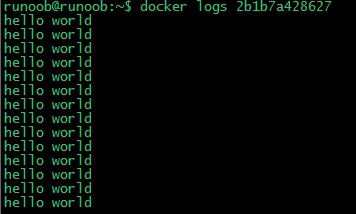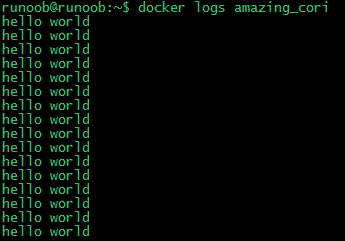Docker Hello World
Docker allows you to run applications within a container. Use the docker run command to run an application within a container.
Output Hello world
php@php:~$ docker run ubuntu:15.10 /bin/echo "Hello world" Hello world

Each parameter analysis:
docker: Docker binary executable file.
run:Combined with the previous docker to run a container.
ubuntu:15.10Specify the image to be run. Docker first checks whether the image exists on the local host. If it does not exist, Docker will retrieve it from the image warehouse Docker Hub Download public images.
/bin/echo "Hello world": Commands executed in the started container
The above commands are complete The meaning can be interpreted as: Docker creates a new container with the ubuntu15.10 image, then executes bin/echo "Hello world" in the container, and then outputs the result.
Run interactive containers
We use the two parameters of docker -i -t to allow the container run by docker to realize the "dialogue" ability
php@php:~$ docker run -i -t ubuntu:15.10 /bin/bash root@dc0050c79503:/#
Analysis of each parameter:
-t:Specify a pseudo terminal or terminal in the new container.
-i:Allows you to interact with the standard input (STDIN) within the container.
At this point we have entered a container of ubuntu15.10 system
We try to run the command in the container cat /proc/versionandlsView the version information of the current system and the file list in the current directory respectively

We can exit the container by running the exit command or using CTRL+D.
Start the container (background mode)
Use the following command to create a container running as a process
php@php:~$ docker run -d ubuntu:15.10 /bin/sh -c "while true; do echo hello world; sleep 1; done" 2b1b7a428627c51ab8810d541d759f072b4fc75487eed05812646b8534a2fe63

In the output , we did not see the expected "hello world", but a long string of characters
2b1b7a428627c51ab8810d541d759f072b4fc75487eed05812646b8534a2fe63
This long string is called the container ID, for each container are all unique, we can use the container ID to see what happened to the corresponding container.
First of all, we need to confirm that the container is running. You can check it through docker ps
php@php:~$ docker ps

CONTAINER ID: Container ID
NAMES:Automatically assigned container name
Use the docker logs command in the container to view the standard output in the container
php@php:~$ docker logs 2b1b7a428627

php@php:~$ docker logs amazing_cori

Stop the container
We use the docker stop command to stop the container:

Check through docker ps and the container has stopped working:
php@php:~$ docker ps

You can also use the following command to stop:
php@php:~$ docker stop amazing_cori








